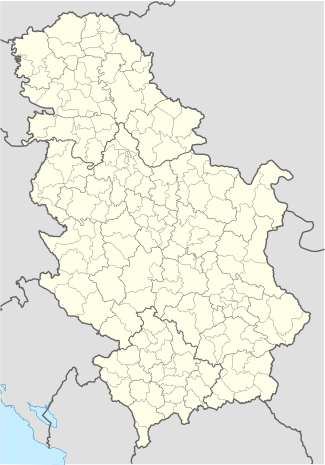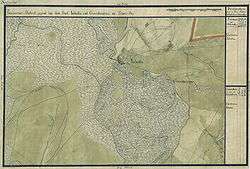Jabuka
| Jabuka Јабука | ||
|---|---|---|
| Village | ||
| ||
 Jabuka Location of Jabuka within Serbia | ||
| Coordinates: 44°56′35″N 20°35′35″E / 44.94306°N 20.59306°ECoordinates: 44°56′35″N 20°35′35″E / 44.94306°N 20.59306°E | ||
| Country | Serbia | |
| Province | Vojvodina | |
| District | South Banat | |
| Elevation | 79 m (259 ft) | |
| Population (2011) | ||
| • Jabuka | 6,312 | |
| Time zone | CET (UTC+1) | |
| • Summer (DST) | CEST (UTC+2) | |
| Postal code | 26201 | |
| Area code(s) | +381(0)13 | |
| Car plates | PA | |
of Pančevo
●
Jabuka (Cyrillic: Јабука) is a village situated in the Pančevo municipality, in the South Banat District, Vojvodina province, Serbia. The village has a Serb ethnic majority but is home to the largest ethnic Macedonian population in Serbia by percentage. Jabuka's population as of the 2002 census is 6,312.
Name
The name Jabuka means "apple" in Serbian. The Hungarian and German names for the village have same meaning. In Serbian, the village is known as Jabuka (Јабука), in Macedonian as Јабука, in Hungarian as Torontálalmás (Alma means "apple" in Hungarian) and in German as Jabuka or Apfeldorf ("Apple village"). The German population called the village Jabuka, named after a former destroyed village founded by Serb fishermen;[1] it was named Apfeldorf when the German army occupied the area in World War II.
History

In prehistoric times, there was a human settlement at this location. Development of this settlement was divided into two time periods, one belonging to the prehistoric culture of Vinča, and another to the prehistoric culture of Starčevo. First written records about this settlement are dating from year 1385 during the administration of the Kingdom of Hungary.[2][3] At the end of the 16th century the area of the south-western Banat near the Danube was made of swamps and forests. Except the towns of Pančevo and Kovin there were no other settlements.
The modern village of Jabuka was founded by Serb fishermen [4] in the end of 17th and beginning of the 18th century. They found a big apple tree and hence named their settlement Jabuka ("apple"). In the first half of the 18th century there were about 15 houses in the village. After the peace treaty with the Ottomans in 1726, Claudius Florimund Graf von Mercy, a man with Lorraine origin, took control of the administration of the Military Frontier. He ordered the inhabitants of Jabuka to be members of the border battalion (Grenzbezirkshauptmannschaft) Opovo - Pančevo. The census from 1733 recorded 19 Serb families in the village. Some of the settlers originated from Macedonia,[5] and, according to some opinions, some might originated from Romania or Bulgaria.[6] In the middle of the 18th century, there was 60 houses in the village, and during this time, its inhabitants were Serbs.[7]
The small number of Serb border police was insufficient to control the border. Therefore the captain of the border police, Graf Engelshofer, called for reinforcement from Germany for the border settlements Jabuka, Glogonj, Sefkerin and Opovo at the Janitscharen insurgencies in 1755 - 1756. The German population started to settle here since 1764, and Hungarian since 1766. In the same year (1766), some Serb inhabitants left Jabuka and settled in Crepaja and Dolovo. This old village named Jabuka was destroyed about 1770.
The new settlement was founded 11 km north of Pančevo on the left side of the Tamiš river from 1772 - 1774 near the place of formerly destroyed old Jabuka. In 1774, the population of the village numbered 88 families and this was time when Romanians started to settle in the village. In 1789, many Serbs left Jabuka and settled in Sefkerin. The laying of the foundation stone of the Catholic Church was on 14 November 1833, replacing the ramshackled former church. In 1901, the Romanians founded their Orthodox church dedicated to Saint Dimitrije.

In 1921, the population of the village numbered 3,265 inhabitants, including 2,918 Germans, 348 Romanians, 73 Hungarians, 20 Serbs and Croats, 2 Slovenes, 2 Russians, and 1 Englishman.
During the World War II, the village was under Axis occupation. During the war (from 1941 to 1944), on a location named Stratište near the village, German forces killed more than 10,000 people [8] (Serbs, Jews, and Roma) who mostly were brought from Sajmište concentration camp near Belgrade. At the same place, German army also operated a furnace for burning.[9] In 1945, a monument (memorial pyramid) dedicated to these victims was built, and later, another monument with memorial house was built too.
After the defeat of Axis Powers, in 1944, one part of German population left from the region, together with defeated German army. The remaining Germans of the village were sent to prison camp in Knićanin that existed until 1948. Some of the Germans died in this camp from starvation, cold, and disease. Some were shot or tortured. 423 German civilians from Jabuka did not survive the prison camp. After prison camps were dissolved (in 1948), the remaining German population left Yugoslavia because of economic reasons.
After World War II the village was settled with South Slavic families that originated from all parts of Yugoslavia.[10] Most of the settlers were from Macedonia. 571 Macedonian families settled, mostly originating from Kriva Palanka. According to 1961 census, population of the village numbered 5,245 inhabitants, including 3,471 Macedonians, 1,303 Serbs, 74 Hungarians, 33 Croats, 16 Montenegrins, etc. According to 1971 census, Macedonians comprised 61.48% of population.
 Entry to the village
Entry to the village First settlers' house built around 1770
First settlers' house built around 1770 Church in Jabuka in 1959
Church in Jabuka in 1959
Population
In the first half of the 18th century, Jabuka had been populated by Serbs, including some settlers from Macedonia as well.[2][3] From 1772 to 1944, it was mostly populated by Germans, and some Romanians lived there as well. In the time period following the World War II, Macedonians, Serbs and others were settled in the village. Main part of post-WW2 settlers were Macedonians. Immediately after the war, 3,464 Macedonians were settled in the village.[11] By 1971 census, population of the village included 3,380 Macedonians, 1,261 Serbs and 668 Roma. The village today has a Serb ethnic majority and its population is 6,312 (2002 census). Besides Serbs (numbering 3,224 people), the village also have a large ethnic Macedonian minority (numbering 2,054 people). Macedonians are an officially recognized minority population in Jabuka.[12] There are also members of other ethnic groups as well.
Population and major ethnic groups through history:
| Year | Total | Germans | Romanians | Croats | Macedonians | Serbs | Hungarians | Roma | Yugoslavs |
| 1833 | 2200 | 1840 | 360 | - | - | - | - | - | - |
| 1921 | 3265 | 2901 | 348 | 16 | - | - | - | - | - |
| 1944 | 2603 | 2323 | 260 | 16 | - | 4 | - | - | - |
| 1946 | 3784 | 14 | 260 | - | 3480 | 28 | 2 | - | - |
| 1971 | 5453 | 2 | 140 | - | 3380 | 1261 | 2 | 668 | - |
| 1981[13] | 6598 | - | - | 37 | 4179 | 1567 | 60 | - | 312 |
| 1991 | 5453 | 8 | 93 | 16 | 3177 | 2143 | 45 | 2 | 910 |
| 2002 | 6312 | 1 | 79 | 14 | 2054 | 3224 | 27 | 24 | 307 |
Culture
Given that Jabuka was mostly populated with Macedonian immigrants during the 1950s and 1960s, much of the cultural life of the village reflects these people's traditions. Macedonians living in Jabuka are united by the cultural organisation "Jabuka", whilst local Romani people have formed the "Crni Biseri" association.[14] In 1961 the cultural house "Kočo Racin" was founded in the village. Every year the national holiday Ilinden is celebrated by Macedonians in the village,[15] whist since 2008 the ethno-festival Tavče Gravče has been also celebrated in the village.
Sports
There is a football club named "OFK Jugoslavija" in the village. It was founded in 1936 as "SFJ" (Sodafabrik Jabuka), in 1950 it changed its name to OFK. Since 1959, there is a handball club named "Jabuka".
See also
References
- ↑ "Jabuka-Zvaničana prezentacija grada Pančeva". Pancevo.rs. Retrieved 2013-08-16.
- 1 2 pancevo.rs
- 1 2 pancevo.rs (page cache)
- ↑ "Jabuka-Zvaničana prezentacija grada Pančeva". Pancevo.rs. Retrieved 2013-08-16.
- ↑ "Jabuka-Zvaničana prezentacija grada Pančeva". Pancevo.rs. Retrieved 2013-08-16.
- ↑ Simo Mladenovski, Banatsko selo Jabuka, Skopje, 1988.
- ↑ Dr Slobodan Ćurčić, Naselja Banata - geografske karakteristike, Novi Sad, 2004.
- ↑ "Jabuka-Zvaničana prezentacija grada Pančeva". Pancevo.rs. Retrieved 2013-08-16.
- ↑ jabuka.org.yu (page cache)
- ↑ "Jabuka-Zvaničana prezentacija grada Pančeva". Pancevo.rs. Retrieved 2013-08-16.
- ↑ Trifunoski, Jovan F.: O posleratnom naseljavanju stanovnistva iz NR Makedonije u tri banatska naselja: Jabuka, Kacarevo i Glogonj, Novi Sad: Matica Srpska, 1958. Simo Mladenovski: Banatskoto selo Jabuka. S. 89.
- ↑ "Македонскиот службен јазик во војводинско Дужине". Vecer.com.mk. Retrieved 2013-08-16.
- ↑ http://pod2.stat.gov.rs/ObjavljenePublikacije/G1981/Pdf/G19814001.pdf
- ↑ Macedonian house in Jabuka
- ↑ Јабука е синоним за Македонците во Војводина
- Simo Mladenovski, Banatsko selo Jabuka, Skopje, 1988.
- Dr Slobodan Ćurčić, Naselja Banata - geografske karakteristike, Novi Sad, 2004.
- e-novine.com
External links
| Wikimedia Commons has media related to Jabuka. |
